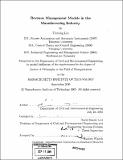| dc.contributor.advisor | David Simchi-Levi. | en_US |
| dc.contributor.author | Liu, Tieming, Ph. D. Massachusetts Institute of Technology | en_US |
| dc.contributor.other | Massachusetts Institute of Technology. Dept. of Civil and Environmental Engineering. | en_US |
| dc.date.accessioned | 2006-07-31T15:28:52Z | |
| dc.date.available | 2006-07-31T15:28:52Z | |
| dc.date.copyright | 2005 | en_US |
| dc.date.issued | 2005 | en_US |
| dc.identifier.uri | http://hdl.handle.net/1721.1/33736 | |
| dc.description | Thesis (Ph. D.)--Massachusetts Institute of Technology, Dept. of Civil and Environmental Engineering, 2005. | en_US |
| dc.description | Includes bibliographical references (p. 107-110). | en_US |
| dc.description.abstract | In recent years, many manufacturing companies have started exploring innovative revenue management technologies in an effort to improve their operations and ultimately their bottom lines. Methods such as differentiating customers based on their sensitivity to price and delays are employed by firms to increase their profits. These developments call for models that have the potential to radically improve supply chain efficiencies in much the same way that revenue management has changed the airline industry. In this dissertation, we study revenue management models where customers can be separated into different classes depending on their sensitivity to price, lead time, and service. Specifically, we focus on identifying effective models to coordinate production, inventory and admission controls in face of multiple classes of demand and time- varying parameters. We start with a single-class-customer problem with both backlogged and discretionary sales. Demand may be fulfilled no later than N periods with price discounts if the inventory is not available. If profitable, demand may be rejected even if the inventory is still available. | en_US |
| dc.description.abstract | (cont.) For this problem we analyze the structure of the optimal policy and show that it is characterized by three state-independent control parameters: the produce-up-to level (S), the reserve-up-to level (R), and the backlog-up-to level (B). At the beginning of each period, the manufacturer will produce to bring the inventory level up to S or to the maximum capacity; during the period, s/he will set aside R units of inventory for the next period, and satisfy some customers with the remaining inventory, if expected future profit is higher; otherwise, s/he will satisfy customers with the inventory and backlog up to B units of demands. Then, we analyze a single-product, two-class-customer model in which demanding (high priority) customers would like to receive products immediately, while other customers are willing to wait in order to pay lower prices. For this model, we provide a heuristic policy characterized by three threshold levels: S, R, B. | en_US |
| dc.description.abstract | (cont.) In this policy, during each period, the manufacturer will set aside R units of inventory for the next period, and satisfy some high priority customers with the remaining inventory, if expected future profit is higher; otherwise, s/he will satisfy as many of the high priority customers as possible and backlog up to B units of lower priority customers. Finally, we examine production, rationing, and admission control policies in manufacturing systems with both make-to-stock(MTS) and make-to-order(MTO) products. Two models are analyzed. In the first model, which is motivated by the automobile industry, the make-to-stock product has higher priority than the make-to-order product. In the second model, which is motivated by the PC industry, the manufacturer gives higher priority to the make-to-order product over the make-to-stock product. We characterize the optimal production and order admission policies with linear threshold levels. We also extend those results to problems where low-priority backorders can be canceled by the manufacturer, as well as to problems with multiple types of make-to-order products. | en_US |
| dc.description.statementofresponsibility | by Tieming Liu. | en_US |
| dc.format.extent | 110 p. | en_US |
| dc.format.extent | 5024618 bytes | |
| dc.format.extent | 5029174 bytes | |
| dc.format.mimetype | application/pdf | |
| dc.format.mimetype | application/pdf | |
| dc.language.iso | eng | en_US |
| dc.publisher | Massachusetts Institute of Technology | en_US |
| dc.rights | M.I.T. theses are protected by copyright. They may be viewed from this source for any purpose, but reproduction or distribution in any format is prohibited without written permission. See provided URL for inquiries about permission. | en_US |
| dc.rights.uri | http://dspace.mit.edu/handle/1721.1/7582 | |
| dc.subject | Civil and Environmental Engineering. | en_US |
| dc.title | Revenue management models in the manufacturing industry | en_US |
| dc.type | Thesis | en_US |
| dc.description.degree | Ph.D. | en_US |
| dc.contributor.department | Massachusetts Institute of Technology. Department of Civil and Environmental Engineering | |
| dc.identifier.oclc | 65171068 | en_US |
